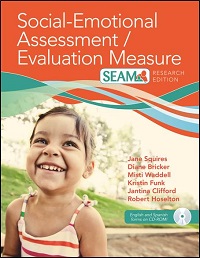The Social-Emotional Assessment/Evaluation Measure (SEAM) is an assessment tool for measuring children’s social-emotional development and parenting competence.
SEAM was developed by some of the key developers and trainers for the Ages & Stages Questionnaires: Social-Emotional, Second Edition (ASQ:SE-2) screener: Jane Squires, Ph.D., Diane Bricker, Ph.D., Misti Waddell, M.S., Kristin Funk, M.A., LCSW, Jantina Clifford, Ph.D., and Robert Hoselton.
What is the age range of children assessed?
The SEAM Tool – includes three intervals with different developmental ranges: Infant (2–18 months), Toddler (18–36 months), and Preschool (36–66 months) and helps identify a child’s strengths, concerns for the family that need monitoring, and agreed-on focus areas
The SEAM Family Profile – also has three developmental intervals and assesses parent and caregiver strengths and helps identify areas in which they need more supports and resources to foster their child’s social-emotional skills
(The SEAM system also includes SEAM with Ages, an alternate version of the tool annotated with a helpful list of age ranges for each item.)
For each interval, the Tool assesses 10 child benchmarks critical to social-emotional competence:
- Child participates in healthy interactions
- Child expresses a range of emotions
- Child regulates social-emotional responses
- Child begins to show empathy for others
- Child attends to and engages with others
- Child explores hands and feet and surroundings (for infants)/demonstrates independence (for toddlers/preschoolers)
- Child displays a positive self-image
- Child regulates activity level
- Child cooperates with daily routines and requests
- Child shows a range of adaptive skills
The Family Profile also measures four benchmarks key to a nurturing home environment for each interval:
- responding to needs
- providing activities and play
- providing predictable routines and an appropriate environment, and
- ensuring home safety
In early childhood programs, homes, or other settings where children are served
Early interventionists, early childhood teachers, Head Start & Early Head Start staff, home visitors, parent educators, and mental health professionals
How long does it take to complete?
15–30 minutes (SEAM/SEAM with Ages)
10–15 minutes (Family Profile)
What languages is it available in?
English and Spanish (both are included on the CD-ROM)
Yes, SEAM has been researched with 2,200 children from 49 U.S. states and Canada.
How can the results be used?
Qualitative data from the SEAM and Family Profile can be used to determine areas for greater intervention; answers can be converted to numerical values for progress monitoring.




